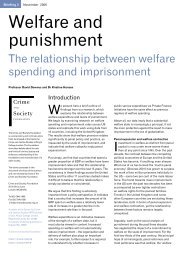PRISON SERVICE
PRISON SERVICE
PRISON SERVICE
- No tags were found...
You also want an ePaper? Increase the reach of your titles
YUMPU automatically turns print PDFs into web optimized ePapers that Google loves.
Graduates’ mean A scores decreased from 23.7pre-treatment to 19.4 post-treatment (Representing adecreased anticipation of re-offending). This decrease ishighly significantParticipants’ post-treatment feedbackPost-treatment feedback using a 5-point Likertscale revealed that 37.5 per cent of graduates ratedtheir risk of relapse in the next year as ‘Very low’ andthe same proportion (37.5 per cent) rated their risk as‘Low’. 21.9 per cent rated their risk as ‘Medium.’ Only3.1 per cent of graduates rated their risk as ‘High’ andnone of the graduates considered their risk ‘Very high.’These responses fit well with thehigh levels of confidence foundin post-treatment Alcohol TakingConfidence scores.Participants’ post-treatmentfeedback provides anencouraging indication that theADTP is effectively linkingparticipants to peer andprofessional support and leadingto affiliation with AA, 81 per centof participants rated their level ofsupport for staying sober inprison as ‘High’ or ‘Very High’and 75.0 per cent rated theircommunity support similarly. Inaddition, post-treatmentfeedback from graduatesindicated high levels of perceivedsupport with regard to avoiding re-offending postrelease.The majority of participants also reported highlevels of commitment to attending twelve-step AAmeetings indicating that one of the chief objectives ofthe ADTP’s programme to encourage AA affiliation ismet effectively. ADTP counsellors report the majority ofgraduates who remain in custody do continue to attendAA meetings and outside speaker meetings, suggestingthat the ratings reflect actual levels of affiliation.DiscussionIn February, 2010 HM Inspectorate of Prisonsproduced a short thematic review of Alcohol services inprisons. Their report highlights the gaps that currentlyexist between the needs of prisoners with alcoholproblems and the services available in prisons to meetthose needs. Their report suggests that nearly one infive prisoners have an alcohol problem, and that amongthe young offender population this rises to 30 per cent.Their reporthighlights the gapsthat currently existbetween the needsof prisoners withalcohol problemsand the servicesavailable in prisonsto meetthose needs.Women are also highlighted in their report aspresenting with a need for alcohol services; theysuggest that around 29 per cent would benefit from analcohol intervention..While there is an acknowledge need to addressalcohol related offending criminal justice agencies havetraditionally focused their attention on drug relatedcrime. In the United Kingdom we have developedNational Strategies supported by significant levels offunding to address the problems of illicit drug use —however, there remains a conspicuous absence offunding to address the social and economicconsequences of alcohol related crime.The Mental Health Screen used as part of theassessment process indicated thatalcohol dependent prisoners arelikely to present with a range ofmental health problems. Inaddition, they are likely to havehousing and throughcare needsthat if left unaddressed are likelyto impact on the offenders’s riskof reoffending on release. ManyADTP participants come intotreatment with low levels of socialsupport. Participants’ posttreatmentfeedback provides anencouraging indication that theADTP is effectively linkingparticipants to peer andprofessional support and leadingto affiliation with AA. The resultspresented in this paper supportthe notion that the use of evidence based interventionwith alcohol dependent offenders can significantlyreduce this risk.In response to the Prime Minister’s Alcohol HarmReduction Strategy the Prison Service published astrategy in 2004 to support the new emphasis onaddressing alcohol related crime. The Prison Service’sstrategy states that it will increase provision whereresources are available — however, the opportunity toincrease alcohol provision will remain severely restricteduntil a greater proportion of the available resources areallocated to the provision of alcohol services. NOMScommissioners, and the Reducing Re-offendingProgrammes Group, have recognised this challenge,and are trying to increase the availability of resources todevelop services to alcohol dependent offenders. Thisprocess is welcome, particularly as it is accompanied bythe development of accredited programmes for thistarget group of offenders in prison and in thecommunity, that have proven positive results.14 Prison Service JournalIssue 192











